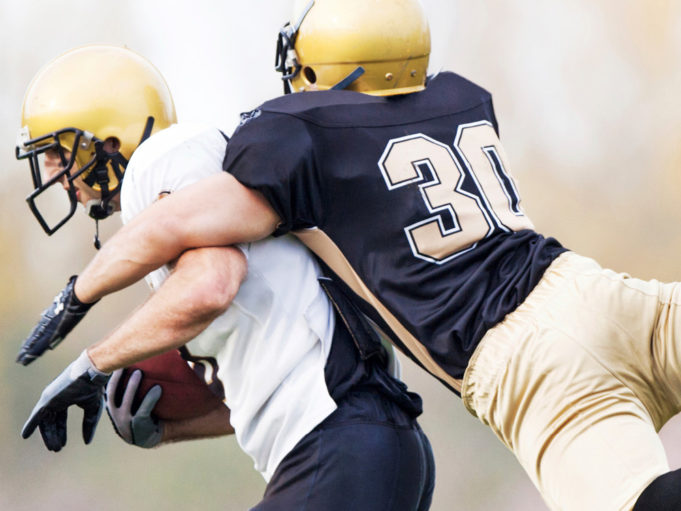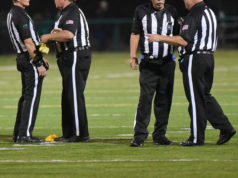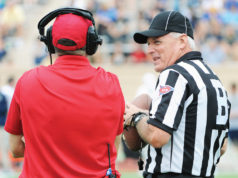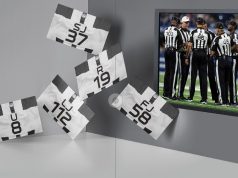Whether it’s dry or wet, artificial or natural, the surface on which the game is played can have a marked influence on how the game is played and on specific plays. Muddy fields favor the running game. Many believe a slick field helps the players on offense because they know where they are going, while the defense doesn’t. When a runner slips and goes down by rule, no one credits the ground with the tackle. Instead, the closest defender gets the stat. There are several scenarios, though, in which the ground can be a factor.
The ground cannot cause a fumble.
That’s an oft-spoken phrase in football. Actually the ground can cause a fumble under NCAA and NFHS rules even though there is no requirement for a runner to be down by contact. It would, however, be a very rare occurrence.
The veracity of that phrase lies in the fact that, 99.9 percent of the time, when the ball is freed from the runner’s grip as it hits the ground, the ball is already dead. It is dead because a part of the runner’s body other than a hand or foot had touched the ground before the ball touched the ground. That body part might be a knee, the side of a thigh or the forearm. Contact with the ground by any of those body parts causes the ball to become dead. Forward progress is marked at the foremost point of the ball when the contact with the ground occurred.
So how can the ground cause a fumble? While in a runner’s possession, the ball contacts the ground before any part of the runner’s body other than a hand or foot, and that contact causes the runner to lose control of the ball, then indeed the ground has “caused” a fumble. As you can imagine it would be a most unusual play. The runner would have to either stumble and try to use the ball to regain his balance, he could “lay out” or be flipped heels over head, so that the ball contacts the ground before the rest of the runner’s body, other than perhaps, the free hand.
The ground can cause an incomplete pass.
Catching a ball involves more than simply gaining control of it. It means gaining possession of the ball in flight and first coming to the ground inbounds (NFHS 2-4-1; NCAA 2-2-7). If an airborne player receives the ball and lands so his first contact is inbounds, he has caught the ball. Barring contact by an opponent, if the first contact is out of bounds, there is no catch and the pass is incomplete. If a player controls the ball while airborne, but loses possession when he lands, there is no catch. Thus, the ground can cause an incomplete pass.
One fairly common scenario is a player who gains control of a ball in flight while he is in mid-air. He then comes to the ground with a foot just inside the sideline and falls to the ground out of bounds. When the player contacts the ground, the ball pops out from his hands. That may occur either with or without the ball contacting the ground.
Some will argue that is a completed pass because the catch was completed when his foot touched the ground. Admittedly, the player has certainly complied with the exact requirements of the rule, but the key is “possession.” While it appeared to the eye that the player gained possession of the ball, the fact that the ball came loose upon contact with the ground is proof the player did not have sufficient control to satisfy the rule. That sort of qualifies as “evidence after the fact,” but that’s what the rule requires.
That principle applies regardless of where the airborne receiver comes to the ground: out of bounds, inbounds, in the middle of the field or the end zone. In the preceding scenario, the play did not end when the receiver’s foot touched the ground inbounds — the ball remained live. Such a play ends when the receiver touches out of bounds and, as described, the ball becomes loose at the time it is to be declared dead.
Let’s take the same airborne receiver and have him gain control between the hashmarks above the end zone. He then comes to the ground in the following sequence: first foot, second foot, hip, back. The ball pops free when his back contacts the turf. Is that a catch? One argument can be that not only was the catch complete when the first foot touched the ground, but the ball was dead because it was in the end zone. Again, failure to maintain control of the ball until the player has completely come to the ground indicates that the rule requiring possession was not satisfied. The result is an incomplete pass.
The ground cannot commit a personal foul.
Perhaps that’s not as widely known as the first two phrases, but it’s certainly valid. That phrase was probably coined by Randy Campbell of the Mountain West Conference. Randy uses that phrase to encourage officials not to stare down at the ground after a play ends (a common fault among prep officials, especially when marking the progress spot). Dead-ball fouls, especially at a sideline, are almost always formulated in the mind of the perpetrator while the ball is live and executed within three seconds after the ball becomes dead.
In order for a late hit to occur, the potential offender must be in proximity of an opponent. Piling on or late hits near the runner are relatively easy to catch because officials tend to watch the player with the ball. Fouls away from the play are more difficult, but only because some crews are not disciplined to keep all 22 players in view after the play ends. It’s not difficult to maintain vigilance for three seconds and it is a key component ofgood dead-ball officiating.
Of course, dead-ball fouls can occur after the threesecond vigilance period. Opponents may begin the dead-ball interval with verbal jousting that escalates to physical confrontation. The syllables themselves may constitute taunting. Officials should monitor all bantering among opponents. If opponents remain near each other after a play ends, there is a potential problem and the nearest official should close in and let his presence be known. In many cases that will be enough to deter any extracurricular activity.
A common distraction to dead-ball officiating is the ball itself. Some officials incorrectly make chasing the ball their first priority after the play ends. That task should be left to the ball boys if the ball has gone outside the sideline and to the players if it remains on the field. It is OK if the game is momentarily delayed while the ball is retrieved. The teams will eventuallyget into the routine of taking care of the unneeded ball.
If necessary and the circumstances permit, an official can fetch the ball once all players have started to return to their huddle or a new position.
What's Your Call? Leave a Comment:
Note: This article is archival in nature. Rules, interpretations, mechanics, philosophies and other information may or may not be correct for the current year.
This article is the copyright of ©Referee Enterprises, Inc., and may not be republished in whole or in part online, in print or in any capacity without expressed written permission from Referee. The article is made available for educational use by individuals.


















